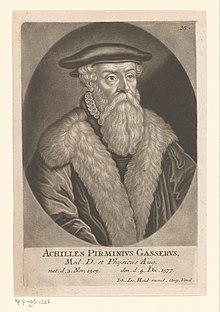| Achilles Gasser | |
|---|---|
 | |
| Born | (1505-11-03)3 November 1505 Lindau, Holy Roman Empire |
| Died | 4 December 1577(1577-12-04) (aged 72) Mixed Imperial City of Augsburg, Holy Roman Empire |
| Known for | Comet observations, research on European history and geography |
| Scientific career | |
| Fields | |
Achilles Pirmin Gasser (3 November 1505 – 4 December 1577) was a German physician and astrologer. He is now known as a well-connected humanistic scholar, and supporter of both Copernicus and Rheticus.
Life
Born in Lindau, he studied mathematics, history, and philosophy, as well as astronomy. He was a student in Sélestat under Johannes Sapidus [it]; he also attended universities in Wittenberg, Vienna, Montpellier, and Avignon.
In 1528, German cartographer Sebastian Münster appealed to scientists across the Holy Roman Empire to assist him with his description of Germany. Gassar accepted this and was later recognized by Münster as a close collaborator for his cartography of the country.
Rheticus lost his physician father Georg Iserin in 1528 when he was executed on sorcery charges. Gasser later took over the practice in Feldkirch, in 1538; he taught Rheticus some astrology, and helped his education, in particular by writing to the University of Wittenberg on his behalf.
When Rheticus printed his Narratio prima—the first published account of the Copernican heliocentric system—in 1540 (Danzig), he sent Gasser a copy. Gasser then undertook a second edition (1541, Basel) with his own introduction in the form of a letter from Gasser to Georg Vogelin of Konstanz. The second edition (1566, Basel) of De revolutionibus orbium coelestium contained the Narratio Prima with this introduction by Gasser.
Works

He prepared the first edition (Augsburg, 1558) of the Epistola de magnete of Pierre de Maricourt.
Other works include:
- Historiarum et Chronicorum totius mundi epitome (1532)
- Prognosticon (1544) dedicated to Thomas Venatorius [de]
- Edition of the Evangelienbuch of Otfried of Weissenburg. His edition did not appear until 1571, under the name of Matthias Flacius who had taken over.
- Observations on comets
Gasser belonged with Flacius to the humanist circle around Kaspar von Niedbruck [de], concerned with the recovery of monastic manuscripts. Others in the group were John Bale, Conrad Gesner, Joris Cassander, Johannes Matalius Metellus, and Cornelius Wauters.
Notes
- Also Gassar, Gasserus, Gassarus.
- Blendinger, Friedrich (1964), "Gasser, Achilles Pirminius", Neue Deutsche Biographie (in German), vol. 6, Berlin: Duncker & Humblot, p. 79; (full text online)
- ^ "Archived copy". Archived from the original on 29 September 2011. Retrieved 22 September 2011.
{{cite web}}: CS1 maint: archived copy as title (link) - Peter G. Bietenholz and Thomas Brian Deutscher, Contemporaries of Erasmus: a biographical register of the Renaissance and Reformation (2003), Volume 3, p. 196; Google Books.
- ^ Danielson, Dennis (2004), "Achilles Gasser and the birth of Copernicanism", Journal for the History of Astronomy, 35 Part 4 (121): 457–474, Bibcode:2004JHA....35..457D, doi:10.1177/002182860403500406, ISSN 0021-8286, S2CID 115298364.
- Burmeister, Karl Heinz (1970). "Achilles Gasser as Geographer and Cartographer". 24. Bregenz: Imago Mundi: 57.
{{cite journal}}: Cite journal requires|journal=(help) - Burmeister, Karl Heinz (1970). "Achilles Gasser (1505-1577) as Geographer and Cartographer". Imago Mundi. 24. Bregenz: Imago Mundi, Ltd.: 57–58. doi:10.1080/03085697008592350 – via JSTOR.
- MacTutor page on Rheticus Archived 27 August 2011 at the Wayback Machine
- Repcheck, pp. 113–4.
- "Nicolaus Copernicus". The Stanford Encyclopedia of Philosophy. Metaphysics Research Lab, Stanford University. 2019.
- "NICOLAUS COPERNICUS THORUNENSIS - the history of the editions of de revolutionibus".
- Herbermann, Charles, ed. (1913). "Pierre de Maricourt" . Catholic Encyclopedia. New York: Robert Appleton Company.
- Anthony Grafton, Cardano's Cosmos: the worlds and works of a Renaissance astrologer (1999), p. 56; Google Books
- Dictionaries in Early Modern Europe (PDF), p. 122.
- Kokott, W., The Comet of 1533, p. 105.
- Kees Dekker and Cornelis Dekker, The Origins of Old Germanic Studies in the Low Countries (1999), p. 21; Google Books.
References
- Jack Repcheck (2007), Copernicus' Secret: How the Scientific Revolution Began
- Karl Galle, Scientist of the Day - Achilles Pirmin Gasser
Further reading
- Karl Heinz Burmeister [de] (1970), Achilles Pirmin Gasser, 1505-1577. Arzt u. Naturforscher, Historiker und Humanist. (3 volumes.)
- Karl Heinz Burmeister, Achilles Pirmin Gasser (1505-1577) as Geographer and Cartographer, Imago Mundi Vol. 24, (1970), pp. 57–62; https://www.jstor.org/stable/1150458
External links
- (in German) de:s:ADB:Gasser, Achilles Pirminius
- CERL page
- (in French) Old dictionary entry
- Galle, Karl (3 November 2021). "Scientist of the Day - Achilles Pirmin Gasser".